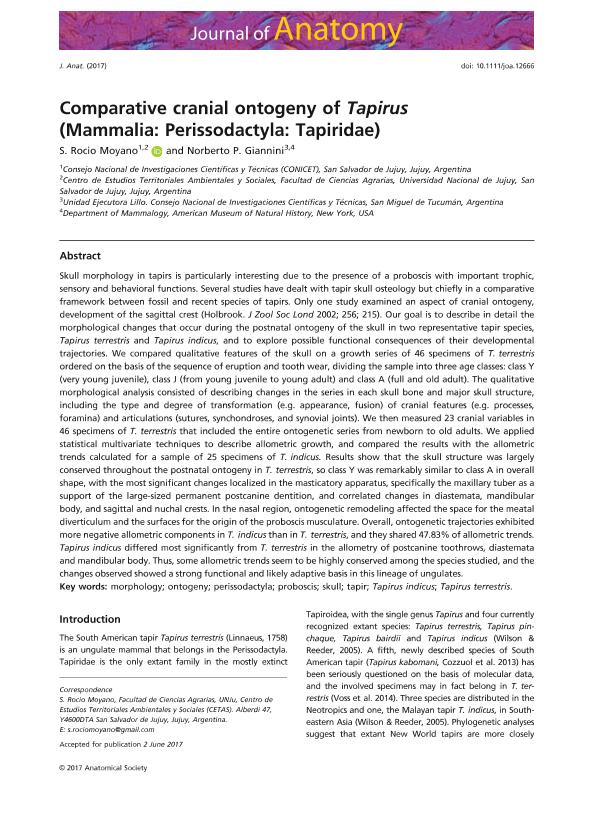Mostrar el registro sencillo del ítem
dc.contributor.author
Moyano, Silvana Rocio

dc.contributor.author
Giannini, Norberto Pedro

dc.date.available
2018-09-04T16:02:37Z
dc.date.issued
2017-07
dc.identifier.citation
Moyano, Silvana Rocio; Giannini, Norberto Pedro; Comparative cranial ontogeny of Tapirus (Mammalia: Perissodactyla: Tapiridae); Wiley Blackwell Publishing, Inc; Journal of Anatomy; 231; 5; 7-2017; 665-682
dc.identifier.issn
0021-8782
dc.identifier.uri
http://hdl.handle.net/11336/58239
dc.description.abstract
Skull morphology in tapirs is particularly interesting due to the presence of a proboscis with important trophic, sensory and behavioral functions. Several studies have dealt with tapir skull osteology but chiefly in a comparative framework between fossil and recent species of tapirs. Only one study examined an aspect of cranial ontogeny, development of the sagittal crest (Holbrook. J Zool Soc Lond 2002; 256; 215). Our goal is to describe in detail the morphological changes that occur during the postnatal ontogeny of the skull in two representative tapir species, Tapirus terrestris and Tapirus indicus, and to explore possible functional consequences of their developmental trajectories. We compared qualitative features of the skull on a growth series of 46 specimens of T. terrestris ordered on the basis of the sequence of eruption and tooth wear, dividing the sample into three age classes: class Y (very young juvenile), class J (from young juvenile to young adult) and class A (full and old adult). The qualitative morphological analysis consisted of describing changes in the series in each skull bone and major skull structure, including the type and degree of transformation (e.g. appearance, fusion) of cranial features (e.g. processes, foramina) and articulations (sutures, synchondroses, and synovial joints). We then measured 23 cranial variables in 46 specimens of T. terrestris that included the entire ontogenetic series from newborn to old adults. We applied statistical multivariate techniques to describe allometric growth, and compared the results with the allometric trends calculated for a sample of 25 specimens of T. indicus. Results show that the skull structure was largely conserved throughout the postnatal ontogeny in T. terrestris, so class Y was remarkably similar to class A in overall shape, with the most significant changes localized in the masticatory apparatus, specifically the maxillary tuber as a support of the large-sized permanent postcanine dentition, and correlated changes in diastemata, mandibular body, and sagittal and nuchal crests. In the nasal region, ontogenetic remodeling affected the space for the meatal diverticulum and the surfaces for the origin of the proboscis musculature. Overall, ontogenetic trajectories exhibited more negative allometric components in T. indicus than in T. terrestris, and they shared 47.83% of allometric trends. Tapirus indicus differed most significantly from T. terrestris in the allometry of postcanine toothrows, diastemata and mandibular body. Thus, some allometric trends seem to be highly conserved among the species studied, and the changes observed showed a strong functional and likely adaptive basis in this lineage of ungulates.
dc.format
application/pdf
dc.language.iso
eng
dc.publisher
Wiley Blackwell Publishing, Inc

dc.rights
info:eu-repo/semantics/openAccess
dc.rights.uri
https://creativecommons.org/licenses/by-nc-sa/2.5/ar/
dc.subject
Morphology
dc.subject
Ontogeny
dc.subject
Perissodactyla
dc.subject
Proboscis
dc.subject
Skull
dc.subject
Tapir
dc.subject
Tapirus Indicus
dc.subject
Tapirus Terrestris
dc.subject.classification
Otras Ciencias Biológicas

dc.subject.classification
Ciencias Biológicas

dc.subject.classification
CIENCIAS NATURALES Y EXACTAS

dc.title
Comparative cranial ontogeny of Tapirus (Mammalia: Perissodactyla: Tapiridae)
dc.type
info:eu-repo/semantics/article
dc.type
info:ar-repo/semantics/artículo
dc.type
info:eu-repo/semantics/publishedVersion
dc.date.updated
2018-08-30T13:32:57Z
dc.journal.volume
231
dc.journal.number
5
dc.journal.pagination
665-682
dc.journal.pais
Reino Unido

dc.journal.ciudad
Londres
dc.description.fil
Fil: Moyano, Silvana Rocio. Consejo Nacional de Investigaciones Científicas y Técnicas; Argentina. Universidad Nacional de Jujuy. Facultad de Ciencias Agrarias. Centro de Estudios Ambientales Territoriales y Sociales; Argentina
dc.description.fil
Fil: Giannini, Norberto Pedro. Consejo Nacional de Investigaciones Científicas y Técnicas. Centro Científico Tecnológico - Tucumán. Unidad Ejecutora Lillo; Argentina. American Museum of Natural History; Estados Unidos
dc.journal.title
Journal of Anatomy

dc.relation.alternativeid
info:eu-repo/semantics/altIdentifier/url/http://doi.wiley.com/10.1111/joa.12666
dc.relation.alternativeid
info:eu-repo/semantics/altIdentifier/doi/https://dx.doi.org/10.1111/joa.12666
Archivos asociados
